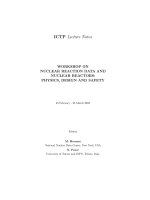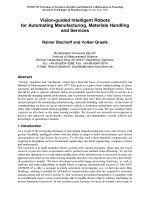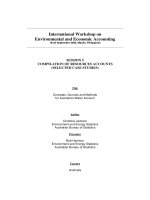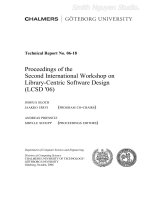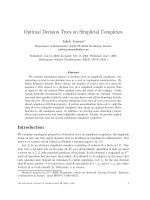K Nearest Neighbor Model Decision Trees Workshop on Data Analytics
Bạn đang xem bản rút gọn của tài liệu. Xem và tải ngay bản đầy đủ của tài liệu tại đây (957.18 KB, 50 trang )
Workshop on Data
Analytics
Tanujit Chakraborty
Mail :
K-Nearest Neighbor Model
Decision Trees
Nearest Neighbor Classifiers
Basic idea:
If it walks like a duck, quacks like a duck, then it’s probably a
duck
Compute
Distance
Training
Records
Choose k of the
“nearest” records
Test Record
Basic Idea
k-NN classification rule is to assign to a test sample the
majority category label of its k nearest training samples
In practice, k is usually chosen to be odd, so as to avoid
ties
The k = 1 rule is generally called the nearest-neighbor
classification rule
Basic Idea
kNN does not build model from the training data.
To classify a test instance d, define k-neighborhood P as k
nearest neighbors of d
Count number n of training instances in P that belong to
class cj
Estimate Pr(cj|d) as n/k
No training is needed. Classification time is linear in
training set size for each test case.
Definition of Nearest Neighbor
X
(a) 1-nearest neighbor
X
X
(b) 2-nearest neighbor
(c) 3-nearest neighbor
K-nearest neighbors of a record x are data points that
have the k smallest distance to x
Nearest-Neighbor Classifiers: Issues
– The value of k, the number of nearest
neighbors to retrieve
– Choice of Distance Metric to compute
distance between records
– Computational complexity
– Size of training set
– Dimension of data
Value of K
Choosing the value of k:
If k is too small, sensitive to noise points
If k is too large, neighborhood may include points from
other classes
Rule of thumb:
K = sqrt(N)
N: number of training points
X
Distance Metrics
Distance Measure: Scale Effects
Different features may have different measurement scales
E.g., patient weight in kg (range [50,200]) vs. blood protein
values in ng/dL (range [-3,3])
Consequences
Patient weight will have a much greater influence on the
distance between samples
May bias the performance of the classifier
Standardization
Transform raw feature values into z-scores
zij =
x ij - m j
sj
x ijis the value for the ith sample and jth feature
m j is the average of all x ij for feature j
s j is the standard deviation of all x ijover all input samples
Range and scale of z-scores should be similar (providing
distributions of raw feature values are alike)
Decision Trees
11
Training Examples
Day
D1
D2
D3
D4
D5
D6
D7
D8
D9
D10
D11
D12
D13
D14
Outlook
Sunny
Sunny
Overcast
Rain
Rain
Rain
Overcast
Sunny
Sunny
Rain
Sunny
Overcast
Overcast
Rain
Temp
Hot
Hot
Hot
Mild
Cool
Cool
Cool
Mild
Cool
Mild
Mild
Mild
Hot
Mild
Humidity
High
High
High
High
Normal
Normal
Normal
High
Normal
Normal
Normal
High
Normal
High
Wind Tennis?
Weak
No
Strong
No
Weak
Yes
Weak
Yes
Weak
Yes
Strong
No
Strong
Yes
Weak
No
Weak
Yes
Weak
Yes
Strong
Yes
Strong
Yes
Weak
Yes
Strong
No
Representation of Concepts
Decision trees: disjunction of conjunction of attributes
• (Sunny AND Normal) OR (Overcast) OR (Rain AND Weak)
• More powerful representation
• Larger hypothesis space H
• Can be represented as a tree
• Common form of decision
OutdoorSport
making in humans
sunny
overcast
rain
Humidity
Yes
Wind
high
normal
strong
weak
No
Yes
No
Yes
13
Decision Trees
• Decision tree to represent learned target functions
– Each internal node tests an attribute
– Each branch corresponds to attribute value
– Each leaf node assigns a classification
Outlook
• Can be represented
by logical formulas
sunny
overcast
rain
Humidity
Yes
Wind
high
normal
strong
weak
No
Yes
No
Yes
14
Representation in decision trees
Example of representing rule in DT’s:
if outlook = sunny AND humidity = normal
OR
if outlook = overcast
OR
if outlook = rain AND wind = weak
then playtennis
15
Applications of Decision Trees
Instances describable by a fixed set of attributes and their values
Target function is discrete valued
– 2-valued
– N-valued
– But can approximate continuous functions
Disjunctive hypothesis space
Possibly noisy training data
– Errors, missing values, …
Examples:
Equipment or medical diagnosis
– Credit risk analysis
– Calendar scheduling preferences
–
16
Attribute 2
Decision Trees
+ + + +
+ + + +
+ + + +
-
-
-
-
-
-
-
-
+ + + +
+ + + +
+ + + +
Given distribution
Of training instances
Draw axis parallel
Lines to separate the
Instances of each class
+ + + +
+ + + +
+ + + +
Attribute 1
17
Attribute 2
Decision Tree Structure
+ + + +
+ + + +
+ + + +
-
-
-
-
-
-
-
-
+ + + +
+ + + +
+ + + +
Draw axis parallel
Lines to separate the
Instances of each class
+ + + +
+ + + +
+ + + +
Attribute 1
18
Decision Tree Structure
Attribute 2
Decision leaf
+ + + +
+ + + +
+ + + +
-
30
-
-
-
-
-
-
* Alternate splits possible
-
+ + + +
+ + + +
+ + + +
Decision node
= condition
= box
+ + + +
+ + + +
+ + + +
= collection of satisfying
examples
Decision nodes (splits)
20
40
Attribute 1
19
Decision Tree Construction
• Find the best structure
• Given a training data set
20
Top-Down Construction
Start with empty tree
Main loop:
1. Split the “best” decision attribute (A) for next node
2. Assign A as decision attribute for node
3. For each value of A, create new descendant of node
4. Sort training examples to leaf nodes
5. If training examples perfectly classified, STOP,
Else iterate over new leaf nodes
Grow tree just deep enough for perfect classification
– If possible (or can approximate at chosen depth)
Which attribute is best?
21
Attribute 2
Best attribute to split?
+ + + +
+ + + +
+ + + +
-
-
-
-
-
-
-
-
+ + + +
+ + + +
+ + + +
+ + + +
+ + + +
+ + + +
Attribute 1
22
Attribute 2
Best attribute to split?
+ + + +
+ + + +
+ + + +
-
-
-
-
-
-
-
-
+ + + +
+ + + +
+ + + +
+ + + +
+ + + +
+ + + +
Attribute 1 > 40?
Attribute 1
23
Attribute 2
Best attribute to split?
+ + + +
+ + + +
+ + + +
-
-
-
-
-
-
-
-
+ + + +
+ + + +
+ + + +
+ + + +
+ + + +
+ + + +
Attribute 1 > 40?
Attribute 1
24
Which split to make next?
Pure box/node
Attribute 2
Mixed box/node
+ + + +
+ + + +
+ + + +
-
-
-
-
-
-
Attribute 1 > 20?
-
-
+ + + +
+ + + +
+ + + +
Already pure leaf
No further need to split
+ + + +
+ + + +
+ + + +
Attribute 1
25

